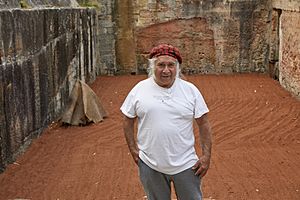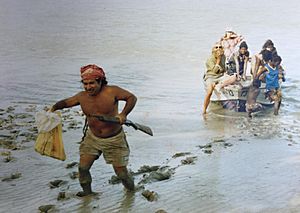Djon Mundine facts for kids
Quick facts for kids
Djon Mundine
|
|
|---|---|
 |
|
| Born |
John Mundine
1951 (age 73–74) Grafton, New South Wales, Australia
|
| Awards | Red Ochre Award |
Djon Mundine OAM (born 1951) is a famous Aboriginal Australian artist, curator, activist, and writer. He is a proud member of the Bundjalung people from northern New South Wales. Djon is especially known for creating the idea behind the important 1988 artwork called Aboriginal Memorial. This amazing artwork is now on display at the National Gallery of Australia in Canberra.
Contents
Early Life and Background
Djon Mundine was born in Grafton, New South Wales in 1951. He was the sixth of eleven children in his family. His father, Roy Mundine, was a stockman who worked with unions. Djon's grandfather, on his mother's side, was part of the first Indigenous Australian political group, the Australian Aboriginal Progressive Association, in the 1920s.
Even though his family was very poor, Djon remembers his father encouraging them to think and talk about important topics. In 1963, his family moved to Sydney. Djon went to Marist Brothers schools in Auburn and Parramatta.
Djon is a Wehbal man from the West Bundjalung nation, which is in the Northern Rivers area of New South Wales. He also has family connections to the Yuin people. Growing up in South Grafton, Djon learned about traditional Aboriginal art and techniques from a young age.
Art Career and Famous Works
Djon Mundine decided that university wasn't for him. Instead, he became an art adviser at the Milingimbi Art Centre in 1979. Later, he worked as a curator and adviser at Bula'Bula Arts in Ramingining, Arnhem Land, for 16 years.
The Aboriginal Memorial
While working in Ramingining, Djon came up with the idea for the famous Aboriginal Memorial. This artwork is now a permanent display at the National Gallery of Australia in Canberra.
From 1979 to 1995, Djon lived and worked in remote Aboriginal communities. He served as an art adviser in places like Ramingining, Milingimbi, and Maningrida. He says this time was very important for him and helped shape his ideas about art.
The Aboriginal Memorial is a powerful work of contemporary Indigenous Australian art. It includes 200 decorated hollow log coffins. These logs were created to remember the Australian Bicentenary celebrations in 1988. They represent 200 years of European settlement in Australia. The design of the logs comes from a traditional ceremony of Central Arnhem Land. The artwork honors Indigenous Australians who died because of European settlement.
Forty-three artists from Ramingining and nearby communities in Central Arnhem Land helped create this work. Some of these artists included David Malangi, George Milpurrurru, and Philip Gudthaykudthay. The National Gallery of Australia bought the artwork, and it is always on display there. It was first shown at the Sydney Biennale in 1988 and has traveled to galleries around the world.
Other Exhibitions and Projects
Djon Mundine has curated many other important exhibitions.
- The Native Born (1996) was an exhibition at the Museum of Contemporary Art (MCA). It showed traditional weaving and art from the Ramingining community.
- They are Meditating: Bark Paintings from the Museum of Contemporary Art's Arnott Collection (2008) featured over 200 artworks from the Ramingining Collection. Djon organized these works based on different natural environments in the Ramingining area. He showed how the art connected to Aboriginal culture and history.
- In 2008, Djon also created Etched in the Sun at the Drill Hall Gallery in Canberra. This exhibition displayed beautiful art prints made by Aboriginal artists like Judy Watson and Banduk Marika between 1997 and 2007.
- Another exhibition he curated in 2008 was Ngadhu, ngulili, ngeaninyagu: a personal history of Aboriginal art in the Premier State. It was held at the Campbelltown Arts Centre.
- In 2017, Djon curated Four Women: (I Do Belong) Double at the Lismore Regional Gallery. This exhibition was inspired by Nina Simone’s song "Four Women." It explored the identities and strength of Aboriginal and Torres Strait Islander women. Artists like Karla Dickens and Fiona Foley showed their work, celebrating the diversity of Blak womanhood.
- In 2022, Djon led "The Dabee Family Choir Mural Project." This project honored Jimmy and Peggy Lambert, who survived the Dabee Massacre in 1823. Over 60 of their descendants finger-painted their images for the exhibition.
- Djon has also been working on "The Dingo Project" for Ngununggula. This exhibition explores the spiritual stories and history of ancestral dingoes. It features works by artists such as Karla Dickens and Fiona Foley.
As of 2025, Djon Mundine continues to work as an independent curator for First Nations art. He also mentors other First Nations artists.
Other Activities and Contributions
Besides his work at art centers, Djon Mundine has been very involved in the community. He helped start the Association of Northern, Kimberley and Arnhem Aboriginal Artists (ANKAAA) in 1987. He has also held important roles at places like the Art Gallery of NSW and the Museum of Contemporary Art Australia.
Djon is also a writer. He uses his writing to explore art more deeply, looking beyond just the materials and where it came from. In 2001, he co-wrote an essay called "Passion, Rich Collectors and the Export Dollar: The Selling of Aboriginal Art Overseas." This essay looked at how Aboriginal art is sold around the world. It discussed how art can sometimes be changed to fit what Western buyers expect.
From 2005 to 2006, Djon was a research professor at the National Museum of Ethnology in Osaka, Japan.
In 2012, Djon curated "Bungaree: The First Australian" at Mosman Art Gallery. This exhibition featured 15 Indigenous artists. It explored the life of Bungaree, an Aboriginal man who sailed around Australia with Matthew Flinders. Bungaree was a well-known figure in colonial Sydney. He was often painted wearing a red military coat. He might have been the first person called "an Australian" in print.
In October 2023, Djon Mundine supported the "Yes" vote for the 2023 Australian referendum on the Indigenous Voice to Parliament. He shared his opinion on an SBS Television program called Insight.
Djon Mundine has also written about how, in Aboriginal beliefs, flashes of white light or rainbow colors in nature can be signs of a divine presence. He connects this to the cycle of life and death and the spiritual link between living people and their ancestors. This shows that Aboriginal art is not just visual but also deeply connected to memory, nature, and belief.
As a Senior Indigenous Consultant Curator at the Queensland Art Gallery, Djon Mundine has played a key role in showcasing the work of Michael Riley, a pioneering Aboriginal photographer and filmmaker. Djon has written about Riley’s ability to combine personal history, spirituality, and political ideas in his art.
Djon is known for his sharp and thought-provoking essays. He often mixes pop culture with serious commentary. He uses references from movies and books to discuss how Aboriginal identity is shown in modern art.
Honours and Awards
- 1993: Medal of the Order of Australia, for his work in promoting Aboriginal arts, crafts, and culture.
- 2015: Won an award for Bungaree’s Farm at the Australian Museums and Galleries Association MAGNA Awards.
- 2017: Won the first Power Publications Award for Indigenous Art Writing for his essay "The Aboriginal Memorial: Australia's Forgotten War."
- 2020: Received the Red Ochre Award from the Australia Council for the Arts for his lifetime achievements.
Other Roles and Committees
Djon Mundine has served on many important boards and committees, helping to support Aboriginal and Torres Strait Islander arts and culture.
- 2020: Member of the Biennale of Contemporary Art, Festival of Pacific Arts in New Caledonia.
- 1985-2000: Member of the AIATSIS Research Ethics Committee in Canberra.
- 1987: Founding and Executive Member of the Association of Northern, Kimberley and Arnhem Land Australian Aboriginal Artists (ANKA) in Darwin, NT.
- 1989: Member of the Australia Council - Aboriginal & Torres Strait Islander Arts Committee in Canberra.
- He has also been a judge for several art awards, including the Woollahra Small Sculpture Award and the Telstra National Aboriginal & Torres Strait Islander Art Award.
Images for kids



